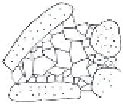Geology Reference
In-Depth Information
Cement rims around grains (symmetrical cements)
Splays:
Fan-like structure consist-
ing of fibrous outward spreading
calcite crystals. The structures may
Isopachous:
Characterized by single
or multiple cement rims growing with
equal thickness around grains. The
cement rim may consist of fibrous,
bladed, or microcrystalline crystals.
occur isolated or within marine cement crusts.
Botryoids:
Complex structures
consisting of various dome-shaped
hemispheres built by radiating fi-
Thickness of the rim within the range of tens of microns to
several millimeters. Common in marine-phreatic and marine-
vadose environments.
Circumgranular
: Characterized by a
cement rim around grains, consisting
of equidimensional crystals forming the
first generation of pore-lining cements.
The rim is commonly thinner than isopachous cement rims.
Meteoric phreatic environment.
brous calcite (originally aragonite) crystals and crystal fans.
Formed on free surfaces as well as in marine cavities.
Pore-filling cement mosaics
Drusy mosaic:
Characterized by
pore-filling
calcite crystals increas-
ing in size toward the center of in-
terparticle pores or voids. Crystals
with compromise boundaries (plane
Cement rims restricted to the underside of grains and void
roofs (asymmetrical cements)
Gravitational:
Pendant beard-like ce-
ments (A) beneath grains. Often asso-
ciated with bridging cements (B, me-
niscus cement) which connect adjacent
grains. Gravitational and bridging ce-
ments (crossing pores and connecting
grains), e.g. meniscus cement and microcrystalline cement,
are irregularly distributed and absent in many pores. Mete-
oric-vadose, meteoric-phreatic and marine-vadose environ-
ments.
intercrystalline boundaries generated by two crystals grow-
ing alongside each other). Burial and near-surface meteoric
environments.
Equant mosaic:
Characterized by
small pore-filling calcite crystals of
approximately equal size. Subhe-
dral and anhedral crystals with well-
developed boundary faces.
Granular mosaic:
Characterized by
small pore-filling calcite crystals
without a preferred orientation and
no substrate control. Meteoric-va-
dose, meteoric-phreatic and burial
environments.
Large cement structures exhibiting geometrical patterns
Crusts:
Millimeter- to centimeter thick
crusts consisting of calcite cements (fi-
brous, radiaxial fibrous, microcrystal-
line) growing on extended substrates
Overgrowth
Syntaxial echinoderm over-
growth:
Fabric characterized by the
dominance of syntaxial calcite ce-
ment, formed as overgrowth usually
on echinoderm skeletal grains within
the sediment. In many places in op-
tical continuity with a substrate of the
(e.g. pore walls, hardgrounds, shells). Cement crusts may
consist of one or more growth zones and may display inter-
nal differentiations (e.g. alternating crusts formed by fibrous
or radiaxial cements and festooned cellular crusts). Marine
and meteoric environments. Chevron crusts, characterized
by V- and inverted V-shape patterns, may sometimes be
caused by neomorphic processes.
same mineralogy.Vadose, meteoric-phreatic, and burial en-
vironments.
Fig. 7.12.
Cement fabrics.
• isopachous and syntaxial cements in the phreatic zone
and gravitational and microstalactitic cements in the
vadose zone,
• vadose cements formed in freshwater environments
(meteoric-vadose cements) and in near-coast marine
environments (marine-vadose cements), both above
the water table,
• sparry calcite cements commonly found either in the
meteoric-phreatic zone at near-surface conditions, or
buried relatively deep (10s-100s m), where mete-
oric water has become more saline.
dogtooth cements, radiaxial fibrous cements, and gravi-
tational cements with algal relict textures.
Marine cements
have characteristic crystal habits and
geochemical signatures. Common cement fabrics as-
sisting in the identification of ancient marine cements
are bladed calcite, fibrous calcite, microcrystalline ce-
ment, and some syntaxial overgrowth cements. The best
indicator of marine diagenesis are hardgrounds (see
Sect. 5.2.4.1).
Common
burial cements
exhibit
• clear coarse calcite spar (calcspar) and coarse equant
spar (ESC) characterized by dull cathodolumines-
cence,
Marine-vadose and mixing zone cements
are mostly
gravitational cements and include cements with bladed
relict textures, cements with the incipient growth of










